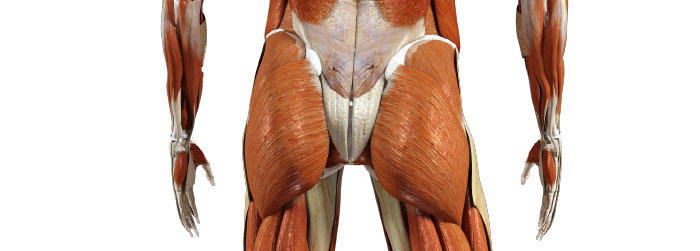Best Exercises for the Gluteus Maximus

The gluteal musculature has been implicated in a variety of pathologies due to its potential impact on lower extremity biomechanics. Read my previous article for an evidence-based discussion of general gluteal strengthening, rehabilitation, EMG activity during exercise, and associated pathologies. Talking specifically about the gluteus maximus, its impaired function has been demonstrated in individuals diagnosed with femoroacetabular impingement.9
Gluteus Maximus Biomechanics
Origin: Ilium posterior to posterior gluteal line; dorsal surface of sacrum and coccyx; sacrotuberous ligament
Insertion: Iliotibial tract and gluteal tuberosity
Primary Function: Extends thigh and assists in hip abduction and external rotation; steadies thigh and assists in rising from seated position
Introductory Exercises
Introductory exercises where the gluteus maximus reaches the highest EMG levels include: 12, 14-18
- Front plank with hip extension
- Gluteal squeeze
- Side plank with hip abduction
- Quadruped with contralateral arm/leg lift
- Unilateral bridge
Interaction With Other Muscles
As I mentioned in the previous article, when we are choosing an exercise to prescribe, we should consider how other muscles interact with or against the gluteus maximus. Individuals demonstrating excess femoral internal rotation during functional tasks may be relying too heavily on the tensor fasciae latae to control their pelvis because their gluteus medium is weak or inhibited.
More Functional Exercises
Finally, when you’re ready to progress your patient towards more functional closed kinetic chain, sport- or activity-specific exercises, consider the following exercises with the highest gluteus maximus activation:12, 14-19
- Cross-over step-up
- Hip thrust variations (barbell, band, American)
- Rotational single-leg squat
- Skater squat
- Single-leg squat
Caveats
Exercise prescription is a multi-faceted decision, which is driven by the individual patient’s goals, functional limitations, and the evidence supporting the treatment of these factors. Using EMG studies to drive the selection of exercise is highly valuable, especially during early rehabilitation or when attempting to isolate individual muscles or groups of muscles.
However, there are limitations when comparing different studies due to methodological differences (type of EMG, patient population, data analysis, etc.). Moreover, thousands of exercises have not been evaluated in the literature because of the costs and time needed to conduct these studies.
So, these studies should be used to guide your decision-making, but they should not override your clinical expertise when accompanied by biological plausibility.
- Powers CM. The Influence of Abnormal Hip Mechanics on Knee Injury: A Biomechanical Perspective. Journal of Orthopaedic & Sports Physical Therapy. 2010;40(2):42-51. doi:10.2519/jospt.2010.3337.
- Powers CM, Ho K-Y, CHEN Y-J, Souza RB, Farrokhi S. Patellofemoral Joint Stress During Weight-Bearing and Non—Weight-Bearing Quadriceps Exercises. Journal of Orthopaedic & Sports Physical Therapy. 2014;44(5):320-327. doi:10.2519/jospt.2014.4936.
- Willson JD. Lower extremity mechanics of females with and without patellofemoral pain across activities with progressively greater task demands. Clinical Biomechanics. 2008;23:203-211. doi:10.1016/j.clinbiomech.2007.08.025.
- Noehren B, Scholz J, Davis I. The effect of real-time gait retraining on hip kinematics, pain and function in subjects with patellofemoral pain syndrome. Br J Sports Med. 2011;45(9):691-6. doi: 10.1136/bjsm.2009.069112.
- Nakagawa TH, Moriya ÉT, Maciel CD, Serrão AF. Frontal plane biomechanics in males and females with and without patellofemoral pain. Med Sci Sports Exerc. 2012 Sep;44(9):1747-55. doi: 10.1249/MSS.0b013e318256903a.
- Qi W. Effect of Increased Iliotibial Band Load on Tibiofemoral Kinematics and Force Distributions: A Direct Measurement in Cadaveric Knees. Journal of Orthopaedic & Sports Physical Therapy. 2013;43(7):478-485. doi:10.2519/jospt.2013.4506.
- Hewett TE. Biomechanical Measures of Neuromuscular Control and Valgus Loading of the Knee Predict Anterior Cruciate Ligament Injury Risk in Female Athletes: A Prospective Study. American Journal of Sports Medicine. 2005;33(4):492-501. doi:10.1177/0363546504269591.
- Franettovich-Smith MM. Neuromotor Control of Gluteal Muscles in Runners with Achilles Tendinopathy. Medicine & Science in Sports & Exercise. January 2014:1-6. doi:10.1249/MSS.0000000000000133.
- Seijas R, Alentorn-Geli E, Álvarez-Díaz P, et al. Gluteus maximus impairment in femoroacetabular impingement: a tensiomyographic evaluation of a clinical fact. Arch Orthop Trauma Surg. February 2016. doi:10.1007/s00402-016-2428-6.
- Santos TRT, Oliveira BA, Ocarino JM, Holt KG, Fonseca ST. Effectiveness of hip muscle strengthening in patellofemoral pain syndrome patients: a systematic review. Braz J Phys Ther. 2015;19(3):167-176. doi:10.1590/bjpt-rbf.2014.0089.
- Garrison JC. EFFECTS OF HIP STRENGTHENING ON EARLY OUTCOMES FOLLOWING ANTERIOR CRUCIATE LIGAMENT RECONSTRUCTION. International Journal of Sports Physical Therapy. 2014;9(2):157-167.
- Reiman MP, Bolgla LA, Loudon JK. A literature review of studies evaluating gluteus maximus and gluteus medius activation during rehabilitation exercises. Physiotherapy Theory and Practice. 2012;28(4):257-268. doi:10.3109/09593985.2011.604981.
- Escamilla RF, et al. Effects of a 4-Week Youth Baseball Conditioning Program on Throwing Velocity. Journal of Strength & Conditioning Research. 2010; Volume 24(12): 3247-3254. doi: 10.1519/JSC.0b013e3181db9f59
- Boren K. Electromyographic Analysis of Gluteus Medius and Gluteus Maximus During Rehabilitation Exercises. International Journal of Sports Physical Therapy. 2011;6(3):206-223.
- Kang S-Y, Jeon H-S, Kwon O, Cynn H-S, Choi B. Activation of the gluteus maximus and hamstring muscles during prone hip extension with knee flexion in three hip abduction positions. Manual Therapy. 2013;18(4):303-307. doi:10.1016/j.math.2012.11.006.
- Selkowitz DM. Which Exercises Target the Gluteal Muscles While Minimizing Activation of the Tensor Fascia Lata? Electromyographic Assessment Using Fine-Wire Electrodes. Journal of Orthopaedic & Sports Physical Therapy. 2013;43(2):54-65. doi:10.2519/jospt.2013.4116.
- Macadam P, Cronin J, Contreras B. AN EXAMINATION OF THE GLUTEAL MUSCLE ACTIVITY ASSOCIATED WITH DYNAMIC HIP ABDUCTION AND HIP EXTERNAL ROTATION EXERCISE: A SYSTEMATIC REVIEW. International Journal of Sports Physical Therapy. 2015;10(5):573-591.
- Bolgla LA, Cruz MF, Roberts LH, Buice AM, Pou TS. Relative electromyographic activity in trunk, hip, and knee muscles during unilateral weight bearing exercises: Implications for rehabilitation. Physiotherapy Theory and Practice. 2016;32(2):130-138. doi:10.3109/09593985.2015.1092059.
- Contreras B, Vigotsky AD, Schoenfeld BJ, Beardsley C, Cronin J. Comparison of Gluteus Maximus, Biceps Femoris, and Vastus Lateralis EMG Amplitude for the Barbell, Band, and American Hip Thrust Variations. Journal of Applied Biomechanics. December 2015. doi:10.1123/jab.2015-0091.









